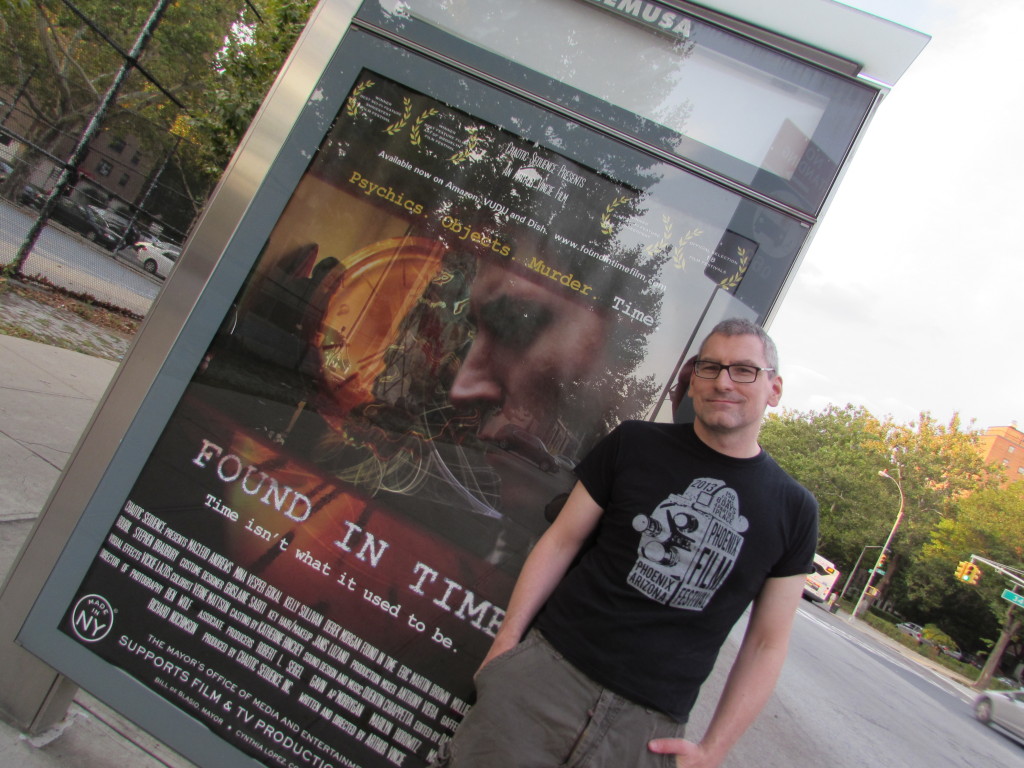We just finished and uploaded a video pitch for Found in Time. You can check it out on IndieGogo.com. In it I try to describe the story, what we’re trying to do in making it, and how you can help us make it happen.
I want to take a moment and thank everyone for their donations of time, energy and money. The making of the video actually highlights another aspect of the DIWO (Do It With Others’) ethos. My friend, writer/director Rick Mowat, donated his video and sound gear. Several other friends and colleagues watched various early versions of the pitch and offered excellent constructive criticism. Bob Seigel, another long-time friend and the legal counsel for the film, made sure all my i’s were dotted and t’s crossed. And Vimeo, Indiegogo, Facebook, Blogger, and Contactology have made it possible to tell people about the pitch for little to no dough.
If you had to add up the real cost of that advice, service, gear, and hosting, it would be quite a bit. So thank you to all who’ve taken time out to help us in our quest to bring the film to fruition.
Some More Business News
As I said in one of my previous posts, the temptation is to just shoot the damn thing. But while you definitely need to have that energy and enthusiasm, you also need to cover your butt and do a few business-type things first. You’ll be happy you did in the long run, and while it will drain some of that enthusiasm away at first, later it will free you from various worries and let you make your film. So here’s an all-too-brief overview of the steps you should take to get your film on the rails.
1. Copyright the script with the U.S. Copyright office:http://www.copyright.gov. For $35 you get your work protected (at least somewhat). Also, SAG will usually require a proof of registration of the script, so just do it.
2. Do a breakdown, schedule and budget for the script, so you know how much to ask for and about how long it will take to shoot. You can hire a line producer for this job (the cost will range from several hundred to a couple of thousand), or do it yourself.
There are definite pros to hiring a line producer. If they have any experience at all, they’ll find and show you the expensive elements in your script, and give you at least an ideal schedule. They also have a good sense of what things cost in the particular place you’re shooting (labor prices, as well as goods and services, vary from region to region).
But I recommend that you do it yourself instead and hire a line producer to check your work. Just don’t kid yourself about how much time it takes – you’ll need a month or more to do this step. But you’ll be learning a valuable skill, and you’ll get to know your script inside and out. It may even help you do a rewrite, both to make things cheaper and also better dramatically.
3. Decide if you’re going to need investors, or if you can get by with your own money plus lots of favors (probably all of them you ever had coming to you) plus a credit card, loan, grant, second mortgage, etc.
I STRONGLY advise you to consider the POSSIBILITY of having investors. It affects many business decisions you’ll make from this point on (see points 4 and 5). And yes, your mom or uncle or whoever who wants to give you money for the film – unless it’s under $1000 or an outright gift – should be considered an investor. Even if you go it alone, any bank down the road will want to see some kind of corporate structure in place before they give you a loan. And psychologically, I think that having to think of other people and their money while you’re making your film can be a good thing – it forces you to examine the film from an outsider’s perspective.
4. If you need investors, put together a business plan. This is a 30-50 page document (or a PowerPoint slideshow) that explains, in as simple terms as possible: what your story is, why it’s special, how it fits into the film marketplace, what your financial goals are with the film, and why anyone in their right minds would want to invest in it.
You can hire other people to do this for you (be prepared to pay a few grand) or learn how to do it yourself. The best book I’ve read on this subject is Louise Levison’s Business Plans for Independents. Again, I recommend you at least try to do it yourself. You may find it a STEEP learning curve, but it will force you to consider your story from yet another perspective.
5. Decide on Incorporation. You’ll need an entity separate from yourself to make the film, hold onto your investor(s)’ money, and deal with all the vendors and crew and SAG. There are several types of business entities, but the most common are:
Subchapter S Corporations: these are designed for small businesses. They offer a “pass-through” mechanism so that income from the corporation is allowed to pass through the corporate “veil” to the owners. S Corps are easy and cheap to form, don’t require a lot of maintenance from the IRS and state tax agency, and can have investors (they become shareholders). You can set up a mechanism whereby you will always own the majority of stock. This keeps you in the driver’s seat while allowing other people to put money into your project.
So what is the problem? Well, because of the “pass-through” regulation, S Corps do offer somewhat less protection from lawsuits which would see to pierce the corporate veil (ie, go after your personal assets). In most states, there’s an upper limit on the number of investors that one S corporation can have. And other corporations or entities can’t become investors.
C Corporations (C corps) offer a solution to all these problems, but aren’t really set up for small business owners. You have a MOUNTAIN more paperwork to file and track, and depending on your budget, you may have to file with the SEC. Trust me on this, you don’t want to create a C Corp.
Limited Liability Partnerships (LLPs) used to be the entity of choice for filmmakers. You become the managing partner; investors become limited partners. The company is structured to give you most of the creative and strategic control, while protecting the investors’ money and legal responsibility (the middle “L”) in case you screw up. But these are relatively clunky, and are treated by the IRS as partnerships, not corporations.
Limited Liability Companies (LLCs) combine elements of corporations and partnerships. You become the Managing Member; investors just become Members. An operating agreement defines the different roles. You’ll have to do a few things (the next few steps) to set up the company.
If you think you’ll have more investors than, say, your uncle, you’ll want to form an LLC. It offers the best combination of protection, paperwork hassle, and flexibility. It’s also “the devil you know” – any investors who are NOT your friends or family will be expecting you to have an LLC.
You don’t have to form an LLC right away, but should do it within the same year you go into production. You’ll need a few weeks to set it (and all your other stuff) up, so you should schedule accordingly.
6. File the incorporation paperwork. Here’s where I get lazy. You can file the paperwork with the state yourself, but I usually use Inc It Now‘s service for the initial filing. They charge a premium but can deliver the filing receipt and other paperwork faster than you’ll get it back from the state otherwise. Expect to pay about $450 or so. Most of this goes to the state filing agency, with the rest paying for postage, your “black beauty” (the big thick book containing your corporate seal and all your corporate documents), and Inc It Now’s service fee. For this you’ll get a filing receipt with the state you incorporated in, a black book with stock certificates and other paperwork, your corporate seal, and your initial articles of organization (a brief contract explaining how the LLC works).
I recommend you incorporate in the same state you’re doing business in. While you can incorporate in a different state, you’ll have to file additional paperwork within your own state to be treated as a “foreign corporation.” You may also have to pay some taxes. It’s more of a pain. Some people maintain that it’s worth it, however, because each state taxes corporations differently. That’s why you’ll see a lot of LLCs that were incorporated in Delaware but do business in New York.
A word of advice on Inc It Now’s services: they have several “packages” available. The best value for your money, however, is to just let them do the initial filing, and for you to handle the following steps (below) yourself.
7. Get an EIN. Once you get the black beauty and the filing certificate, go to the IRS website and file for an EIN. An EIN is the corporate equivalent of a social security number, and you’ll need it to do just about ANYTHING else. Their new online form is pretty good – it’s actually written in English, as opposed to IRS-ese – and you’ll get an EIN right away. Doing this yourself will save you some $$$ over letting Inc. It Now do it for you.
8. Get your filing receipt. A couple of days to a few weeks after you get your black beauty, you’ll also receive a copy of the filing receipt from the state, with a state seal stamped on it. You’ll need this later, so hold onto it.
9. Publish. Depending on what state you incorporated in, you may need to publish a notification of your company’s existence. Two newspapers or circulars publish a daily classified listing stating that your company exists. This is possibly the biggest pain in the ass in this whole ordeal, and apart from a payola scheme, I don’t really know what purpose it serves anymore. I recommend contacting Hudson Advertising if you live in New York (212-732-0337). They get paid by the publishers, so there’s no surcharge to you above the advertising fees (which range from $600 to $1800, depending on the state and, believe it or not, the county of your company’s address). The problem is that if you don’t do this step, the state government can simply declare your corporation invalid. Then you’ll have to start over again.
10. Open a bank account. Once you have your filing receipt and your black beauty, you should open up a checking account with a bank you can tolerate. If you have a budget big enough to justify an escrow account, you’ll want to set up an escrow/production account. This is really two accounts bolted together: an escrow account (where the investor money goes into), and a production account (where you write checks from). You can’t tap the escrow account until you’ve hit the break point (this is up to you to determine). The escrow account can be further set up to track individual investors’ monies, so the bank can send statements back to each investor.
If you’re doing a film for less than $100K, chances are you need whatever money comes in AS it comes in, so you’ll probably want to just set up a simple corporate bank account. You’ll need your EIN and usually the filing receipt or articles of organization (that’ll be in your black beauty), as well as your personal ID.
One important consideration: how many ATMs does this bank operate in the city/town you’ll be shooting in? During production, you’ll often find yourself in need of cash, and you don’t want to piss away money on ATM fees, do you?
11. Set up Your Online Merchant Account. Next (for now), you’ll want to set up an Amazon.com merchant account, and possibly a Paypal account so you can take donations online. These accounts link back to your bank account. Most crowdfunding sites require one or the other (Indiegogo requires an Amazon account).
There are a few more steps to take but you’re probably exhausted from reading this far, so we’ll cover the rest in the next post (I promise). While it all seems like a lot, and it can be somewhat intimidating, if you leave yourself enough time, you’ll be rewarded by (a) learning a lot of new things (which is never bad) and (b) preparing yourself to think like a business person, which you’ll need to do at the other end when you’re trying to sell your film. You’ll also get more acquainted with your script, and may see some things that need changing (it’s always cheaper to figure this out early).




